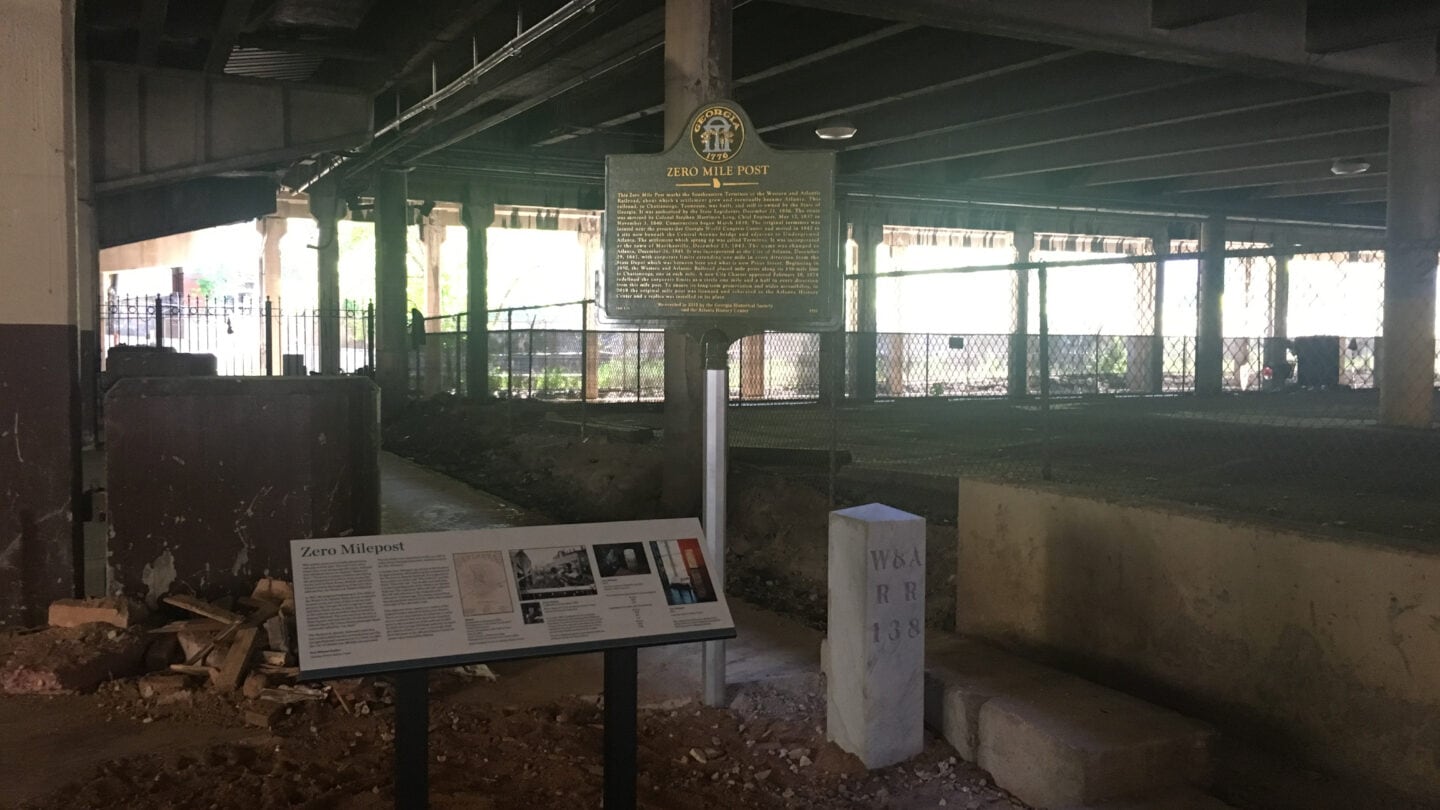The original Western & Atlantic Railroad Zero Milepost on display in the Atlanta History Center exhibition Locomotion: Railroads and the Making of Atlanta, where it is present alongside the W&A locomotive Texas and other artifacts detailing the integral role of the industry in creating Atlanta.
The Zero Milepost of the Western & Atlantic Railroad is an artifact representative of the founding of Atlanta itself.
Now, for the first time since the 1990s, it is accessible to the public and properly preserved, while the original site is clearly marked and viewable by the public.
In 1836, the Georgia General Assembly voted to create the Western & Atlantic Railroad (W&A) to run 138 miles from Chattanooga south to a new site on the Chattahoochee River. The final southern terminus of the W&A was chosen around 1842, when Samuel Mitchell donated land for creating “state square,” the site of both the Union Station of 1853 and the Union Station of 1871. The town called Terminus sprang up around this railroad terminus, and was then renamed Marthasville, and later, Atlanta.
When the City of Atlanta was created in 1847, the terminus of the W&A was designated as the center of the city.
The Zero Milepost was placed on that site around 1850 and continued to be the city center for many years. Eventually, the milepost was obscured by the viaduct system and exposed to the elements following the demolition of the Union Station of 1871.
In the 1990s, the New Georgia Railroad, an excursion passenger train ride, briefly restored the milepost to safety and public accessibility as it became enclosed in the New Georgia’s newly-constructed station. When the railroad was shut down in 1995, however, the building was blocked for private use and eventually locked, and one of Atlanta’s oldest and most significant artifacts became hidden away from the public.
In 2018, the vacant building was slated for demolition by its owner, the Georgia Building Authority (GBA). Atlanta History Center worked with GBA to find a solution that would preserve both the Zero Milepost and the historic site. In October 2018, GBA and Atlanta History Center signed a 5-year renewable license agreement. for Atlanta History Center to house the artifact within the exhibition Locomotion: Railroads and the Making of Atlanta, placing the post in historical context alongside the W&A locomotive Texas. The historic site was surveyed and recorded using GPS coordinates and the milepost was carefully extracted. Shortly after, the building at the original site was demolished by GBA.

The replica Zero Milepost and interpretive signage created by Atlanta History Center, and historical marker re-erected by the Georgia Historical Society and Atlanta History Center on May 14, 2019, mark the historic terminus of the Western & Atlantic Railroad, marked by the Zero Milepost around 1850. This site is located beneath Central Avenue.
In May 2019, Atlanta History Center fulfilled its contractual obligation by installing interpretive signage, a new Georgia Historical Society marker, and a replica Zero Milepost to mark the historic original site. The replica milepost might look a lot shinier than the current milepost—after all, the marble hasn’t undergone 168 years of weathering and harsh conditions, but it was created using rubbings of the original lettering. Although only around 34 inches of the exact replica post is visible above ground, it is actually 7.5 feet tall, matching the height of the original artifact.
Preserving history is never easy—it’s a complicated decision whether to leave fragile historical artifacts in place, or to move them for preservation and public access.
By relocating the Zero Milepost, there are opportunities to bring this important artifact to light once again, spur discussions about the shared history of our city, and have important conversations about the future and best practices of historic preservation in Atlanta.


